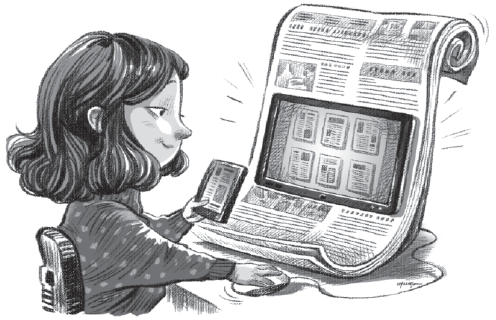The media is not dead but alive and kicking
Updated: 2016-01-12 07:50
By WANG YIQING(China Daily)
|
||||||||
 |
| LI MIN/CHINA DAILY |
The "media is dead" is not a new rant. It was heard even when we were in journalism school. But the "funerals" of the media, especially print media, were held more frequently than ever last year, a disturbing sign for journalists as well as readers and viewers.
According to incomplete data, dozens of newspapers and magazines across the country closed down in 2015. No wonder many people now assume the "print media" is indeed "dying". Still, the expression, the "media is dead", sounds a bit exaggerated.
Rather than mourning the demise of the media, we should try to find out why so many newspapers and magazines winded up operations last year.
A look at the publications that went out of business will show that the majority of them were either regional in character (mainly newspapers) or niche products (especially magazines) targeting special industries and/or people. And technological changes and market competition led to the failure of the first kind of media outlets-akin to "natural selection" or "survival of the fittest" in the media world.
The rapid development of the Internet and information technology, along with the accelerated production of news and widening demands of readers and viewers, has drastically changed the nature of media operations. Regional news papers with limited number of readers don't have the necessary competitive edge in the market, as readers and viewers can now easily access news and information about world affairs.
The closing down of the first kind of media outlets reflects the trend of the times as well as the changing choices of readers and viewers. It is similar to evolution: outdated media outlets get gradually eliminated and stronger ones survive.
As for the fall of the second kind of media outlets, journalists don't seem surprised. Niche media outlets, especially magazines, are perhaps the most vulnerable in the media world because of their limited target groups, high printing costs and their profit model that is highly dependent on advertisements.
- Global health entering new era: WHO chief
- Brazil's planning minister steps aside after recordings revelation
- Vietnam, US adopt joint statement on advancing comprehensive partnership
- European border closures 'inhumane': UN refugee agency
- Japan's foreign minister calls A-bombings extremely regrettable
- Fukushima impact unprecedented for oceans: US expert

 Stars of Lijiang River: Elderly brothers with white beards
Stars of Lijiang River: Elderly brothers with white beards
 Wealthy Chinese children paying money to learn British manners
Wealthy Chinese children paying money to learn British manners
 Military-style wedding: Fighter jets, grooms in dashing uniforms
Military-style wedding: Fighter jets, grooms in dashing uniforms
 Striking photos around the world: May 16 - May 22
Striking photos around the world: May 16 - May 22
 Robots help elderly in nursing home in east China
Robots help elderly in nursing home in east China
 Hanging in the air: Chongqing holds rescue drill
Hanging in the air: Chongqing holds rescue drill
 2.1-ton tofu finishes in two hours in central China
2.1-ton tofu finishes in two hours in central China
 Six things you may not know about Grain Buds
Six things you may not know about Grain Buds
Most Viewed
Editor's Picks

|

|

|

|

|

|
Today's Top News
Liang avoids jail in shooting death
China's finance minister addresses ratings downgrade
Duke alumni visit Chinese Embassy
Marriott unlikely to top Anbang offer for Starwood: Observers
Chinese biopharma debuts on Nasdaq
What ends Jeb Bush's White House hopes
Investigation for Nicolas's campaign
Will US-ASEAN meeting be good for region?
US Weekly

|

|









